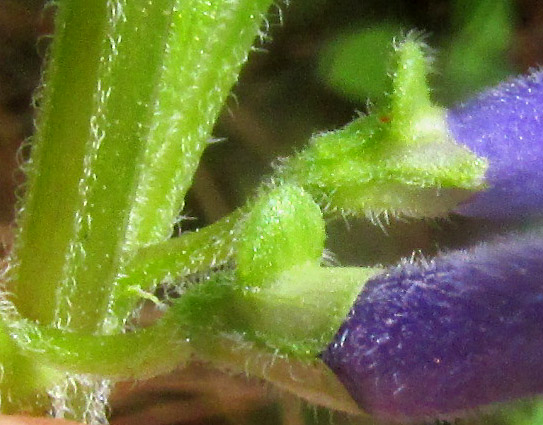Excerpts from Jim Conrad's
Naturalist Newsletter
Entry from field notes dated September 2, 2023, taken in Los Mármoles National Park in the Eastern Sierra Madre mountains, Hidalgo state, MÉXICO; oak-pine forested mountain peak about 3km west of Puerto de Piedra, on road branched off the road between Trancas {on maps designated "Morelos (Trancas)"} and Nicolás Flores; limestone bedrock; elevation ~2,650m (~8,700ft); N20.816°, W99.213°
SCUTELLARIA DUMETORUM

With its pairs of leaves opposite one another on squared stems, the leaves' veins strongly impressed into the blades, the blades being shallow toothed, and flowers strongly bilaterally symmetrical, the above plant bore a strong resemblance to garden mint plants. Up close, the flowers couldn't have looked more minty:

However, currently up to about 7,200 Mint Family species are recognized, in about 236 genera, and since our plant occupies an unusual habitat -- a forested mountain peak often enshrouded in clouds -- it might be an unusual species. The identification process was tremendously simplified by what's shown below:

The calyx was shortly tubular and strongly 2-lipped, which is notable, but what's determinative are the strange, green, tongue-shape items atop the calyxes, known as scutellums. With that, already the plant's genus is revealed, but for good measure, note the short, white hairs restricted to the stem's four sharp corners, plus here's what the plant's lower, branching stem looked like:

When identifying Mint Family species, if you see a calyx with such a scutellum, think "skullcap." The skullcap genus Scutellaria currently incorporates up to 470 skullcap species worldwide, mostly occurring in temperate zones. The 2021 study by José Luis Villaseñor and others entitled "Riqueza y distribución de la flora vascular del estado de Hidalgo, México" reports that here in upland central Mexico's Hidalgo state seven scutellaria species are documented.
Of those seven species, if your skullcap's flowers appear in pairs at stem nodes, and the leaves from whose axils the two flowers arise are as long as twice the length of the flowers or more, you have SCUTELLARIA DUMETORUM. Our plant bears no English name other than the general term skullcap applied to all Scutellaria species with conspicuous scutellums.
Scutellaria dumetorum occurs in upland oak and oak-pine forests throughout most of Mexico except the dry northwestern part, and south possibly to Costa Rica. It's neither commonly occurring nor unusually rare.
Certain skullcaps are famed as medicinal plants, especially Scutellaria baicalensis in Asia and Scutellaria lateriflora in North America. For more than 200 years the American species has been employed as a mild relaxant and as a therapy for anxiety, nervous tension, and convulsions; often it's combined with other herbs such as valerian. However, I find nothing in the literature noting any particular human use for our Scutellaria dumetorum.
It's simply another handsome but low-profile organism doing its modest bit as an oxygen-producing pollinator, an occasional snack for roving herbivores, and an eventual contributor of enriching organic matter to the soil from which it grows.
You may enjoy comparing Scutellaria dumetorum with another variation on the skullcap theme on our Gaumer's Skullcap page.